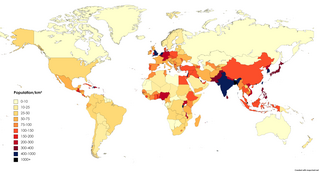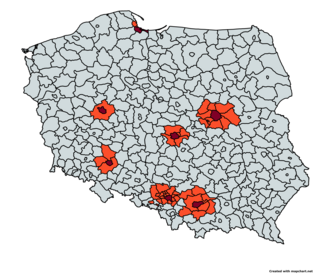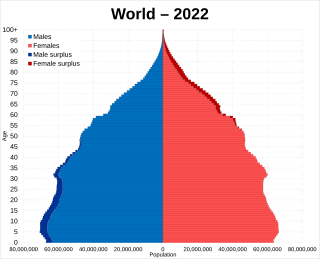
A megacity is a very large city, typically with a population of more than 10 million people. The United Nations Department of Economic and Social Affairs in its 2018 "World Urbanization Prospects" report defines megacities as urban agglomerations with over 10 million inhabitants. A University of Bonn report holds that they are "usually defined as metropolitan areas with a total population of 10 million or more people". Elsewhere in other sources, from five to eight million is considered the minimum threshold, alongside a population density of at least 2,000 per square kilometre. The terms conurbation, metropolis, and metroplex are also applied to the latter.

A metropolitan area or metro is a region consisting of a densely populated urban agglomeration and its surrounding territories sharing industries, commercial areas, transport network, infrastructures and housing. A metropolitan area usually comprises multiple principal cities, jurisdictions and municipalities: neighborhoods, townships, boroughs, cities, towns, exurbs, suburbs, counties, districts and even states and nations in areas like the eurodistricts. As social, economic and political institutions have changed, metropolitan areas have become key economic and political regions.

Population density is a measurement of population per unit land area. It is mostly applied to humans, but sometimes to other living organisms too. It is a key geographical term.

An urban area, built-up area or urban agglomeration is a human settlement with a high population density and an infrastructure of built environment. This is the core of a metropolitan statistical area in the United States, if it contains a population of more than 50,000.

A primate city is a city that is the largest in its country, province, state, or region, and disproportionately larger than any others in the urban hierarchy. A primate city distribution is a rank-size distribution that has one very large city with many much smaller cities and towns and no intermediate-sized urban centers, creating a statistical king effect.

Figures for the population of Europe vary according to the particular definition of Europe's boundaries. In 2018, Europe had a total population of over 751 million people. 448 million of that live in the European Union and 110 million live in European Russia, Russia being the most populous country in Europe.

A city proper is the geographical area contained within city limits. The term proper is not exclusive to cities; it can describe the geographical area within the boundaries of any given locality. The United Nations defines the term as "the single political jurisdiction which contains the historical city centre. The term is synonymous with Central City in the United States which typically contains much of the lower income population. "

The Madrid metropolitan area is a monocentric metropolitan area in the centre of the Iberian peninsula, around the municipality of Madrid, Spain. It is not related to any sort of administrative delimitation, and thus, its limits are ambiguous.

The Katowice urban area, also known as the Upper Silesian urban area, is an urban area/conurbation in southern Poland, centered on Katowice. It is located in the Silesian Voivodeship and in a small part of the Lesser Poland Voivodeship. The Katowice urban area is the largest urban area in Poland and 21st largest urban area in the European Union. According to Demographia, its population is 1,903,000.

The Barcelona urban area is an urban area in Catalonia (Spain) centered on the city of Barcelona and located less than 100 km south of the border with France. With a population of over 5 million, it is one of the largest urban areas in Europe.

This is a list of metropolitan areas in Poland.

Earth has a human population of over 8 billion as of 2024, with an overall population density of 50 people per km2. Nearly 60% of the world's population lives in Asia, with almost 2.8 billion in the countries of China and India combined. The percentage shares of China, India and rest of South Asia of the world population have remained at similar levels for the last few thousand years of recorded history. The world's literacy rate has increased dramatically in the last 40 years, from 66.7% in 1979 to 86.3% today. Lower literacy levels are mostly attributable to poverty. Lower literacy rates are found mostly in South Asia and Sub-Saharan Africa.

A secondary city is an urban hub that fills specific regional and local needs related to governance, economics, finance, education, trade, transportation. A secondary city is defined by population, area, function, and economic status, but also by their relationship to neighboring and distant cities and their socio-economic status. A secondary city may emerge from a cluster of smaller cities in a metropolitan region or may be the capital city of a province, state, or second-tier administrative unit within a country. Secondary cities are the fastest growing urban areas in lower and middle income countries, experiencing unplanned growth and development. By 2030, there will be twice as many medium size cities as there were in 1990, outnumbering the total number of megacities. According to the World Bank, secondary cities make up almost 40% of the world cities population. Many secondary cities in the Global South are expected to undergo massive expansions in the next few decades comparable to city growth in Europe and North America over the past two centuries. These cities are unique environments that generally have limited data and information on infrastructure, land tenure, and planning.

In January 2020, the municipality of Madrid, capital of Spain, had a population of 3,345,894 registered inhabitants in an area of 604.3 square kilometers (233.3 sq mi). Thus, the city's population density was about 5,337 inhabitants per km2. Madrid is Spain's largest city and the second most populous city proper in the European Union, after Berlin.













